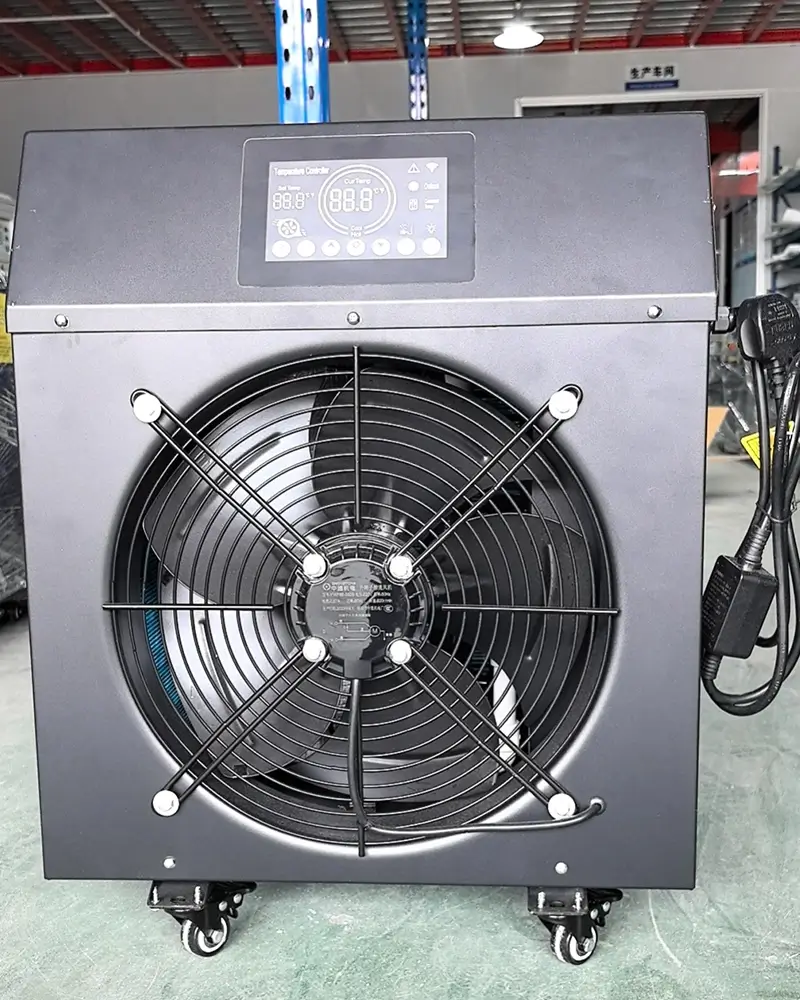Perché l'acqua deve circolare attraverso un refrigeratore?
Perché l'acqua deve circolare attraverso un refrigeratore?
La circolazione dell'acqua aiuta ad assorbire e rimuovere il calore generato dalla macchina, Garantire un controllo costante di temperatura ed eliminare i punti caldi localizzati, che migliora l'efficienza del trasferimento di calore e riduce lo stress termico sull'attrezzatura.
Comprendere l'importanza della circolazione dell'acqua nel mantenimento della qualità dell'acqua e prevenire la scala e l'accumulo di detriti può essere utile. Comprendendo un flusso d'acqua efficiente, puoi migliorare Chiller d'acqua affidabilità, ridurre il consumo di energia operativa, prolungare la durata dell'attrezzatura e garantire prestazioni ottimali e efficacia dei costi.
In che modo il ciclo dell'acqua impedisce al refrigeratore di surriscaldamento?
Senza un'ampia circolazione d'acqua, Il calore si accumulerebbe, causando livelli di temperatura aumentati che possono causare il fallimento o il funzionamento in modo inefficiente dei dispositivi.
La circolazione dell'acqua affidabile assicura che il calore assunto dall'acqua venga continuamente allontanato dall'attrezzatura al Chiller d'acqua. Il refrigeratore d'acqua dissipa quindi questo calore nell'impostazione, Spesso utilizzando una torre di raffreddamento o altri sistemi di scambio di calore. Questa continua rimozione del calore mantiene l'attrezzatura a temperature operative ottimali, impedendo così gli effetti negativi del surriscaldamento.
Inoltre, La circolazione dell'acqua costante aiuta a mantenere una temperatura stabile attorno all'attrezzatura. Le variazioni di temperatura possono innescare lo stress termico, che possono deteriorare i materiali e i componenti nel tempo. Garantendo un flusso stabile d'acqua, Il sistema di refrigeratore d'acqua mantiene la temperatura all'interno di un intervallo sicuro, salvaguardando così l'attrezzatura da danni e prolungando la sua vita operativa.
Un altro elemento vitale è il ruolo della circolazione dell'acqua nella rimozione di hotspot. Gli hotspot sono aree localizzate ad alta temperatura che possono creare quando c'è un raffreddamento inadeguato. Questi punti possono provocare un'espansione termica ineguale, stress meccanico, e possibile fallimento dell'attrezzatura. La circolazione dell'acqua costante ed efficiente aiuta a disperdere l'effetto di raffreddamento equamente su tutte le superfici, prevenire lo sviluppo di tali hotspot.
Perché l'acqua deve essere fatta circolare attraverso un refrigeratore?
L'acqua deve essere diffusa attraverso un refrigeratore per assorbire e trasportare calore lontano dal sistema. Questo processo è essenziale per mantenere gamme di temperatura ottimali, Migliorare l'efficienza, e prevenire potenziali guasti al sistema dovuti al surriscaldamento.
In che modo i refrigeratori impediscono il surriscaldamento delle attrezzature?
La circolazione dell'acqua assorbe e rimuove il calore generato da macchinari e processi industriali. Senza adeguata circolazione dell'acqua, Il calore si accumulerebbe, portando ad un aumento delle temperature che possono causare il fallimento o il funzionamento in modo inefficiente le attrezzature.
Qual è l'impatto della circolazione dell'acqua sul consumo di energia?
La circolazione dell'acqua efficiente influenza direttamente la quantità di energia richiesta per mantenere prestazioni di raffreddamento ottimali. Garantendo che l'acqua si muova continuamente attraverso il refrigeratore, I processi di trasferimento del calore diventano più efficaci, Ridurre la necessità che il refrigeratore funzioni di più e consuma più energia.
In che modo la circolazione dell'acqua migliora il trasferimento di calore e mantiene prestazioni di raffreddamento coerenti nei sistemi refrigerati?
La circolazione dell'acqua efficace garantisce un trasferimento di calore costante ed efficiente dal refrigerante al mezzo di raffreddamento. Questo processo impedisce gli hotspot localizzati e mantiene temperature uniformi, che sono cruciali per prestazioni e efficienza ottimali del refrigeratore. La circolazione dell'acqua costante previene anche squilibri di temperatura e sollecitazione termica sui componenti del sistema, Garantire un funzionamento efficiente e affidabile.
Perché la qualità dell'acqua è importante nei sistemi di circolazione del refrigeratore?
Mantenere l'acqua di alta qualità nei sistemi di circolazione refrigerazione è fondamentale per prevenire problemi come la formazione di scala, corrosione, e crescita biologica. Una corretta circolazione dell'acqua aiuta a ridurre al minimo questi contaminanti, Garantire prestazioni e longevità ottimali dell'attrezzatura.
Come può essere mantenuta la qualità dell'acqua nei sistemi di circolazione del refrigeratore?
Il mantenimento della qualità dell'acqua nei sistemi di circolazione del refrigeratore implica l'uso di metodi di trattamento dell'acqua appropriati, come inibitori chimici per prevenire la scala e la corrosione, e biocidi per controllare la crescita biologica. Monitoraggio e test regolari dei parametri dell'acqua, insieme alla manutenzione ordinaria come la pulizia e il lavaggio del sistema, sono anche essenziali.
Tuttavia, Se scegli Harman N Chiller, Puoi essere sicuro di una qualità dell'acqua superiore. IL Harman n Water Chiller è dotato di ozono, Tecnologia UV, e filtri a doppio livello, Fornire un ulteriore livello di protezione. Questo sistema avanzato ti assicura di poter goderti il tuo bagno di ghiaccio con completa tranquillità, Conoscere l'acqua è sempre pulita e sicura.
Prima della partita
Perché l'acqua deve circolare attraverso un refrigeratore?
La circolazione dell'acqua aiuta ad assorbire e rimuovere il calore generato dalla macchina, Garantire un controllo costante di temperatura ed eliminare i punti caldi localizzati, che migliora l'efficienza del trasferimento di calore e riduce lo stress termico sull'attrezzatura.
Comprendere l'importanza della circolazione dell'acqua nel mantenimento della qualità dell'acqua e prevenire la scala e l'accumulo di detriti può essere utile. Comprendendo un flusso d'acqua efficiente, puoi migliorare Chiller d'acqua affidabilità, ridurre il consumo di energia operativa, prolungare la durata dell'attrezzatura e garantire prestazioni ottimali e efficacia dei costi.
In che modo il ciclo dell'acqua impedisce al refrigeratore di surriscaldamento?
Senza un'ampia circolazione d'acqua, Il calore si accumulerebbe, causando livelli di temperatura aumentati che possono causare il fallimento o il funzionamento in modo inefficiente dei dispositivi.
La circolazione dell'acqua affidabile assicura che il calore assunto dall'acqua venga continuamente allontanato dall'attrezzatura al Chiller d'acqua. Il refrigeratore d'acqua dissipa quindi questo calore nell'impostazione, Spesso utilizzando una torre di raffreddamento o altri sistemi di scambio di calore. Questa continua rimozione del calore mantiene l'attrezzatura a temperature operative ottimali, impedendo così gli effetti negativi del surriscaldamento.
Inoltre, La circolazione dell'acqua costante aiuta a mantenere una temperatura stabile attorno all'attrezzatura. Le variazioni di temperatura possono innescare lo stress termico, che possono deteriorare i materiali e i componenti nel tempo. Garantendo un flusso stabile d'acqua, Il sistema di refrigeratore d'acqua mantiene la temperatura all'interno di un intervallo sicuro, salvaguardando così l'attrezzatura da danni e prolungando la sua vita operativa.
Un altro elemento vitale è il ruolo della circolazione dell'acqua nella rimozione di hotspot. Gli hotspot sono aree localizzate ad alta temperatura che possono creare quando c'è un raffreddamento inadeguato. Questi punti possono provocare un'espansione termica ineguale, stress meccanico, e possibile fallimento dell'attrezzatura. La circolazione dell'acqua costante ed efficiente aiuta a disperdere l'effetto di raffreddamento equamente su tutte le superfici, prevenire lo sviluppo di tali hotspot.
Perché l'acqua deve essere fatta circolare attraverso un refrigeratore?
L'acqua deve essere diffusa attraverso un refrigeratore per assorbire e trasportare calore lontano dal sistema. Questo processo è essenziale per mantenere gamme di temperatura ottimali, Migliorare l'efficienza, e prevenire potenziali guasti al sistema dovuti al surriscaldamento.
In che modo i refrigeratori impediscono il surriscaldamento delle attrezzature?
La circolazione dell'acqua assorbe e rimuove il calore generato da macchinari e processi industriali. Senza adeguata circolazione dell'acqua, Il calore si accumulerebbe, portando ad un aumento delle temperature che possono causare il fallimento o il funzionamento in modo inefficiente le attrezzature.
Qual è l'impatto della circolazione dell'acqua sul consumo di energia?
La circolazione dell'acqua efficiente influenza direttamente la quantità di energia richiesta per mantenere prestazioni di raffreddamento ottimali. Garantendo che l'acqua si muova continuamente attraverso il refrigeratore, I processi di trasferimento del calore diventano più efficaci, Ridurre la necessità che il refrigeratore funzioni di più e consuma più energia.
In che modo la circolazione dell'acqua migliora il trasferimento di calore e mantiene prestazioni di raffreddamento coerenti nei sistemi refrigerati?
La circolazione dell'acqua efficace garantisce un trasferimento di calore costante ed efficiente dal refrigerante al mezzo di raffreddamento. Questo processo impedisce gli hotspot localizzati e mantiene temperature uniformi, che sono cruciali per prestazioni e efficienza ottimali del refrigeratore. La circolazione dell'acqua costante previene anche squilibri di temperatura e sollecitazione termica sui componenti del sistema, Garantire un funzionamento efficiente e affidabile.
Perché la qualità dell'acqua è importante nei sistemi di circolazione del refrigeratore?
Mantenere l'acqua di alta qualità nei sistemi di circolazione refrigerazione è fondamentale per prevenire problemi come la formazione di scala, corrosione, e crescita biologica. Una corretta circolazione dell'acqua aiuta a ridurre al minimo questi contaminanti, Garantire prestazioni e longevità ottimali dell'attrezzatura.
Come può essere mantenuta la qualità dell'acqua nei sistemi di circolazione del refrigeratore?
Il mantenimento della qualità dell'acqua nei sistemi di circolazione del refrigeratore implica l'uso di metodi di trattamento dell'acqua appropriati, come inibitori chimici per prevenire la scala e la corrosione, e biocidi per controllare la crescita biologica. Monitoraggio e test regolari dei parametri dell'acqua, insieme alla manutenzione ordinaria come la pulizia e il lavaggio del sistema, sono anche essenziali.
Tuttavia, Se scegli Harman N Chiller, Puoi essere sicuro di una qualità dell'acqua superiore. IL Harman n Water Chiller è dotato di ozono, Tecnologia UV, e filtri a doppio livello, Fornire un ulteriore livello di protezione. Questo sistema avanzato ti assicura di poter goderti il tuo bagno di ghiaccio con completa tranquillità, Conoscere l'acqua è sempre pulita e sicura.
A proposito di ciò che è autore

Benvenuti nel nostro blog! Il mio nome è Peter e sono l'autore principale di questo blog. Come professionista di recupero sportivo e con profondi interessi e competenze.
Mi impegno a presentare concetti complessi in modo chiaro e conciso, e consentire ai lettori di comprendere meglio e applicare tale conoscenza attraverso una ricerca approfondita e la condivisione dell'esperienza.
Grazie per la lettura e per il tuo supporto! Se hai domande o suggerimenti su uno qualsiasi dei contenuti, Non esitate a contattarmi. Non vedo l'ora di condividere informazioni più interessanti e utili con te e di crescere insieme in questo viaggio di conoscenza!

